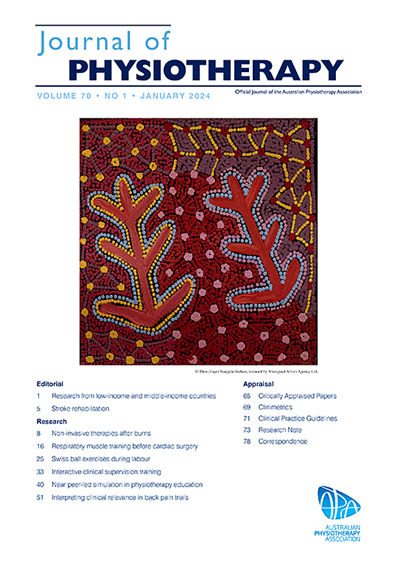Patients with worse disability respond best to cognitive functional therapy for chronic low back pain: a pre-planned secondary analysis of a randomised trial
IF 9.7
1区 医学
Q1 ORTHOPEDICS
引用次数: 0
Abstract
Question
Do five baseline moderators identify patients with chronic low back pain who respond best to cognitive functional therapy (CFT) when compared with usual care?
Design
Secondary analysis of the RESTORE randomised controlled trial.
Participants
A total of 492 adults with low back pain for > 3 months with at least moderate pain-related activity limitation.
Intervention
Participants were allocated to CFT alone or CFT plus biofeedback; these two groups were combined for this secondary analysis. The control group was usual care.
Outcome measures
The outcome was activity limitation measured using the Roland Morris Disability Questionnaire (RMDQ) at 3, 6, 13, 26, 40 and 52 weeks. Investigated effect modifiers were baseline measures of activity limitation, cognitive flexibility, pain intensity, self-efficacy and catastrophising.
Results
Baseline levels of activity limitation and, potentially, cognitive flexibility were associated with different effects of CFT treatment, while pain intensity, self-efficacy and catastrophising were not. Patients who had higher baseline activity limitation had greater treatment effects at 13 and 52 weeks. A person with a baseline RMDQ score of 18 (90th percentile) would on average be 6.1 (95% CI 4.8 to 7.4) points better at 13 weeks if they received CFT compared with usual care. However, a person with a baseline score of 7 (10th percentile) would on average be 3.6 (95% CI 2.6 to 4.6) points better at 13 weeks.
Conclusion
The finding that CFT is most effective among patients who are most disabled and incur the greatest burden strongly suggests that CFT should be considered as a treatment for this group of patients.
Registration
ACTRN12618001396213.
对慢性腰背痛认知功能疗法反应最佳的是残疾程度更严重的患者:随机试验的预先计划二次分析。
问题与常规护理相比,五项基线调节因子是否能确定对认知功能疗法(CFT)反应最佳的慢性腰背痛患者?RESTORE随机对照试验的二次分析:共492名患有腰背痛3个月以上且至少有中度疼痛相关活动受限的成人:干预措施:参与者被分配到单纯CFT或CFT加生物反馈治疗组;这两组合并进行二次分析。对照组为常规护理:结果测量:使用罗兰-莫里斯残疾问卷(RMDQ)测量3、6、13、26、40和52周的活动限制。研究的影响因素包括活动受限基线测量、认知灵活性、疼痛强度、自我效能和灾难化:结果:基线活动受限水平和潜在的认知灵活性与 CFT 治疗的不同效果有关,而疼痛强度、自我效能和灾难化则无关。基线活动受限程度较高的患者在13周和52周时的治疗效果较好。基线 RMDQ 得分为 18 分(第 90 百分位数)的患者如果接受 CFT 治疗,13 周后的平均治疗效果将比常规治疗好 6.1 分(95% CI 4.8-7.4 分)。然而,基线分数为 7 分(第 10 百分位数)的患者在 13 周后的平均治疗效果将提高 3.6 分(95% CI 2.6-4.6 分):结论:CFT 对残疾程度最严重、负担最重的患者最有效,这一发现有力地表明,应考虑将 CFT 作为这部分患者的治疗方法:ACTRN12618001396213。
本文章由计算机程序翻译,如有差异,请以英文原文为准。
求助全文
约1分钟内获得全文
求助全文
来源期刊

Journal of Physiotherapy
ORTHOPEDICS-REHABILITATION
CiteScore
11.40
自引率
7.40%
发文量
69
审稿时长
72 days
期刊介绍:
The Journal of Physiotherapy is the official journal of the Australian Physiotherapy Association. It aims to publish high-quality research with a significant impact on global physiotherapy practice. The journal's vision is to lead the field in supporting clinicians to access, understand, and implement research evidence that will enhance person-centred care. In January 2008, the Journal of Physiotherapy became the first physiotherapy journal to adhere to the ICMJE requirement of registering randomized trials with a recognized Trial Registry. The journal prioritizes systematic reviews, clinical trials, economic analyses, experimental studies, qualitative studies, epidemiological studies, and observational studies. In January 2014, it also became the first core physiotherapy/physical therapy journal to provide free access to editorials and peer-reviewed original research. The Australian Physiotherapy Association extended their support for excellence in physiotherapy practice by sponsoring open access publication of all Journal of Physiotherapy content in 2016. As a result, all past, present, and future journal articles are freely accessible, and there are no author fees for publication.
 求助内容:
求助内容: 应助结果提醒方式:
应助结果提醒方式:


